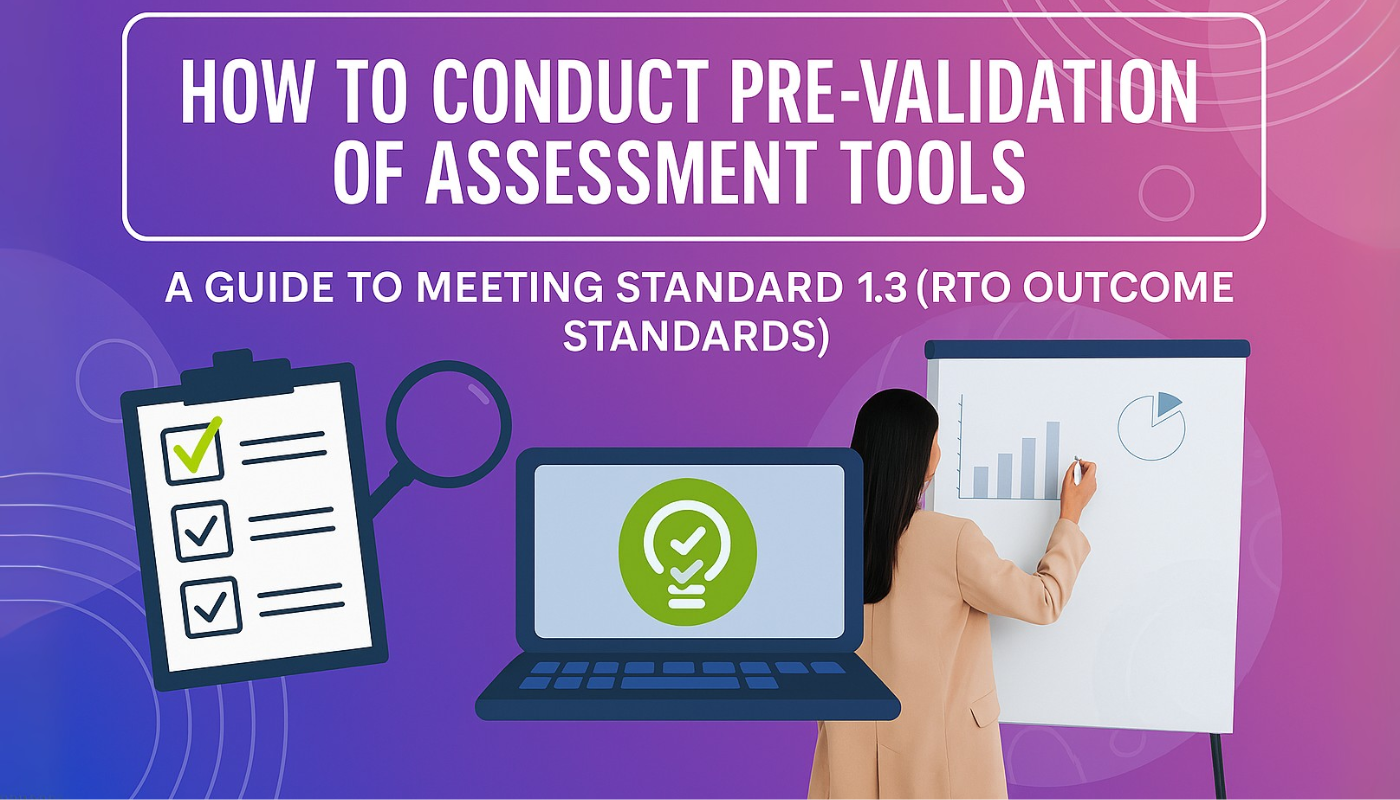📅 Updated for compliance with the Revised Standards for RTOs – Effective 1 July 2025
🔗 Related: ASQA Revised Standards Announcement
Introduction
Under the new Outcome Standards for RTOs 2025, Standard 1.3 places a clear obligation on all Registered Training Organisations (RTOs) to pre-validate their assessment tools.
In simple terms—if you’re not reviewing your assessment tools before delivery begins, you’re putting your students (and your registration) at risk.
This blog will walk you through:
- What Standard 1.3 requires
- Why pre-validation is essential
- How to build your internal pre-validation process
- How to get your free, ready-to-use Pre-Validation Template
What is Standard 1.3?
Outcome Statement
“The assessment system is fit-for-purpose and consistent with the training product.”
Performance Indicators:
To comply with this Standard, your RTO must demonstrate:
- 1.3(a): The assessment aligns with the unit of competency and its assessment requirements.
- 1.3(b): Tools are reviewed before use to ensure they meet the Principles of Assessment and Rules of Evidence (see Standard 1.4).
- 1.3(c): The outcomes of that review are acted on—meaning you revise tools where needed.
In other words, pre-validation is not optional—it is a compliance expectation.
Why Pre-Validation Matters

Here’s a practical process to follow before any assessment tool is used in class:
✅ Step 1: Select the Training Product
Identify the unit or qualification you’re validating against.
✅ Step 2: Collect All Assessment Materials
Include student instructions, marking guides, observation checklists, and evidence plans.
✅ Step 3: Review Mapping
Check that every task is clearly mapped to the unit’s:
- Elements and performance criteria
- Knowledge and performance evidence
- Assessment conditions
✅ Step 4: Apply the Principles of Assessment
- Fairness: Are adjustments possible?
- Flexibility: Can the task be contextualised?
- Validity: Does the task reflect real workplace practice?
- Reliability: Will two assessors reach the same conclusion?
✅ Step 5: Apply the Rules of Evidence
- Validity: Does the evidence match the unit outcomes?
- Sufficiency: Is enough evidence collected?
- Authenticity: Is it clear the student did the work?
- Currency: Is the evidence up-to-date?
✅ Step 6: Identify and Record Issues
Make notes about what needs updating, improving, or removing—this becomes part of your version control and compliance trail.
✅ Step 7: Finalise and Approve
Once all issues are addressed, the tool can be approved for delivery and logged as “ready to use.”
Auditor Insight: Why Pre-Validation Gets Scrutinised
“If assessment tools haven’t been reviewed before delivery, RTOs risk breaching both the outcome and compliance standards. Pre-validation shows that you’re proactive about quality, not just ticking a box after delivery.”
That’s why Standard 1.3 and 1.4 work together—one ensures you prepare for quality, the other ensures you deliver it.
Auditor Insight: Why Pre-Validation Gets Scrutinised
“If assessment tools haven’t been reviewed before delivery, RTOs risk breaching both the outcome and compliance standards. Pre-validation shows that you’re proactive about quality, not just ticking a box after delivery.”
That’s why Standard 1.3 and 1.4 work together—one ensures you prepare for quality, the other ensures you deliver it.
Want to Make It Easy? Get Our FREE Pre-Validation Template!
We’ve created a simple, editable Pre-Validation Checklist and Record Template to help your RTO comply with Standard 1.3—without overwhelm.
✅ Pre-filled with headings aligned to the Outcome Standards
✅ Designed for both face-to-face and online tools
✅ Ideal for internal audits or evidence folders
👉 Click below to request your free copy and get audit-ready today!
Final Thoughts
Pre-validation isn’t an extra step—it’s a core part of your RTO’s quality system.
Start embedding it into your practice now to:

- Protect your learners
- Meet your obligations
- Impress your next auditor
Need help building a full assessment system? I’m here to support with:

- Internal validation systems
- Trainer and assessor coaching
- Audit preparation checklists
📩 Let’s make it easy.
Disclaimer:
The information presented on the VET Resources blog is for general guidance only. While we strive for accuracy, we cannot guarantee the completeness or timeliness of the information. VET Resources is not responsible for any errors or omissions, or for the results obtained from the use of this information. Always consult a professional for advice tailored to your circumstances.






